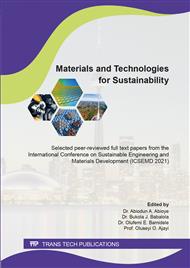[1]
Agashua Lucia O and Ogbiye Adebanji S Influence of Cement, Bitumen and Lime on Some Lateritic Soil Samples as Pavement Material. IOP Conf. Series: Materials Science and Engineering 413 (2018) 012012.
DOI: 10.1088/1757-899x/413/1/012012
Google Scholar
[2]
Agashua Lucia O, Igibah Ehizemhen C and Sadiq, Abubakar. The Impact of Bituminous additive on Lateritic Soil with Varying Percentage for long lasting soil stabilizer (2018).
Google Scholar
[3]
E.A. Adeyanju, C.A. Okeke. Clay soil stabilization using cement kiln dust, in: IOP Conf. Ser. Mater. Sci. Eng. (2019a) p.1–10.
DOI: 10.1088/1757-899x/640/1/012080
Google Scholar
[4]
Adeyanju Emmanuel, Okeke Chukwueloka Austin, Akinwumi Isaac and Busari Ayobami Subgrade stabilization using Rice Husk Ash-Geopolymer (GPHA) and Cement Klin Dust (CKD). (2020).
DOI: 10.1016/j.cscm.2020.e00388
Google Scholar
[5]
E. Adeyanju, C. Okeke. (2019b). Exposure effect to cement dust pollution : a mini review , SN Appl. Sci. 1. 1–17. https://doi.org/10.1007/s42452-019-1583-0.
DOI: 10.1007/s42452-019-1583-0
Google Scholar
[6]
Mengue Emmanuel ; Hussein Mroueh; Laurent Lancelot; and Robert Medjo Eko (2017). Mechanical Improvement of a Fine-Grained Lateritic Soil Treated with Cement for Use in Road Construction, Journal of Materials in Civil Engineering /Volume 29 Issue 11.
DOI: 10.1061/(asce)mt.1943-5533.0002059
Google Scholar
[7]
C.C. Ikeagwuani, D.C. Nwonu, C. Eze and I. Onuoha (2017). Investigation of Shear Strength Parameters and Effect Of Different Compactive Effort On Lateritic Soil Stabilized With Coconut Husk Ash And Lime.
DOI: 10.4314/njt.v36i4.4
Google Scholar
[8]
Vaibhav R. D. and Shrikant, M. H. Influence of Different Soil Properties on Shear Strength of Soil (2016). A Review,, American Journal of Construction and Building Materials, vol. 1, no. 1, pp.24-27.
Google Scholar
[9]
Hasan H, L. Dang, H. Khabbaz, B. Fatahi, S. Terzaghi. (2016). Remediation of Expansive Soils Using Agricultural Waste Bagasse Ash, Procedia Eng. 143, 1368–1375. https://doi.org/10.1016/j.proeng.2016.06.161.
DOI: 10.1016/j.proeng.2016.06.161
Google Scholar
[10]
Ikeagwuani, C. C. Compressibility Characteristics of Black Cotton Soil Admixed with Sawdust Ash and Lime (2016)., Nigerian Journal of Technology, vol. 35, no. 4, pp.718-725.
DOI: 10.4314/njt.v35i4.5
Google Scholar
[11]
Akinwumi, I. I. and Aidomojie, O. I. "Effect of Corncob Ash on the Geotechnical Properties of Lateritic Soil Admixed with Portland Cement (2015). International Journal of Geomatics and Geosciences, vol. 5, no. 3, pp.375-392.
Google Scholar
[12]
M. Ayeldeen, A. Negm, M. El-sawwaf, M. Kitazume, Enhancing mechanical behaviors of collapsible soil using two biopolymers (2017). J. Rock Mech. Geotech. Eng. 9 329–339. https://doi.org/10.1016/j.jrmge.2016.11.007.
DOI: 10.1016/j.jrmge.2016.11.007
Google Scholar
[13]
A.A. Alshaba, T.M. Abdelaziz, A.M. Ragheb (2018). Treatment of collapsible soils by mixing with iron powder. 3737–3745. https://doi.org/10.1016/j.aej.2018.07.019.
DOI: 10.1016/j.aej.2018.07.019
Google Scholar
[14]
E.A. Adeyanju, C.A. Okeke. Clay soil stabilization using cement kiln dust, in: IOP Conf. Ser. Mater. Sci. Eng. (2019a) p.1–10.
DOI: 10.1088/1757-899x/640/1/012080
Google Scholar
[15]
N. Yoobanpot, P. Jamsawang, S. Horpibulsuk, Strength behavior and microstructural characteristics of soft clay stabilized with cement kiln dust and fly ash residue, Appl. Clay Sci. 141 (2017) 146–156. https://doi.org/10.1016/j.clay.2017.02.028.
DOI: 10.1016/j.clay.2017.02.028
Google Scholar
[16]
Ogbiye Adebanji, Busari Ayobami and Adeyanju Emmanuel. Pavement interlayer material improvement using industrial waste: Review of literatures, Int. J. Civ. Eng. Technol.(2018) 9 1114–1122. https://www.scopus.com/inward/record.uri?eid=2-s2.0-85049572285&partner ID=40&md5=bca16f769b74b0b03272297a78dbf409.
Google Scholar


